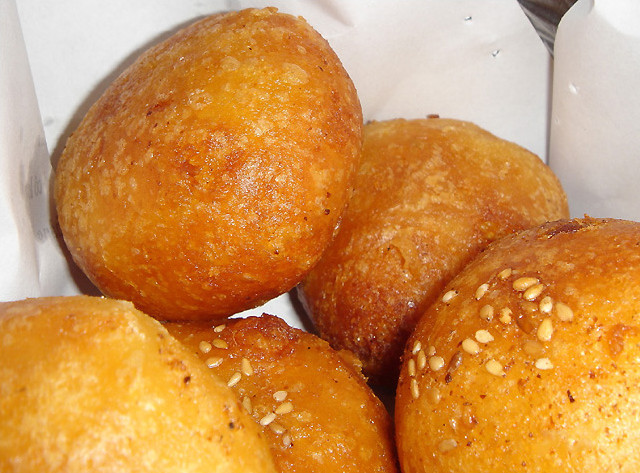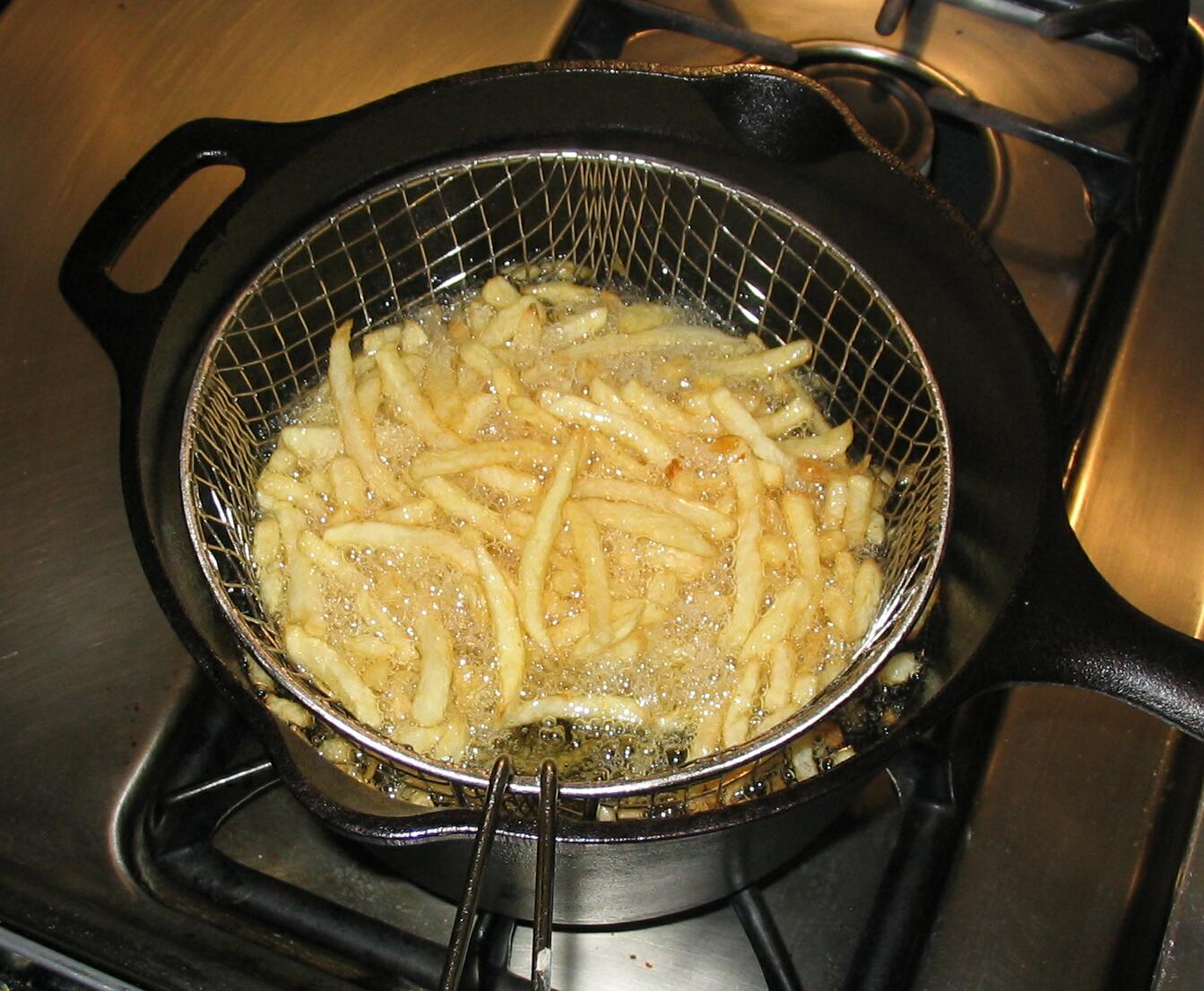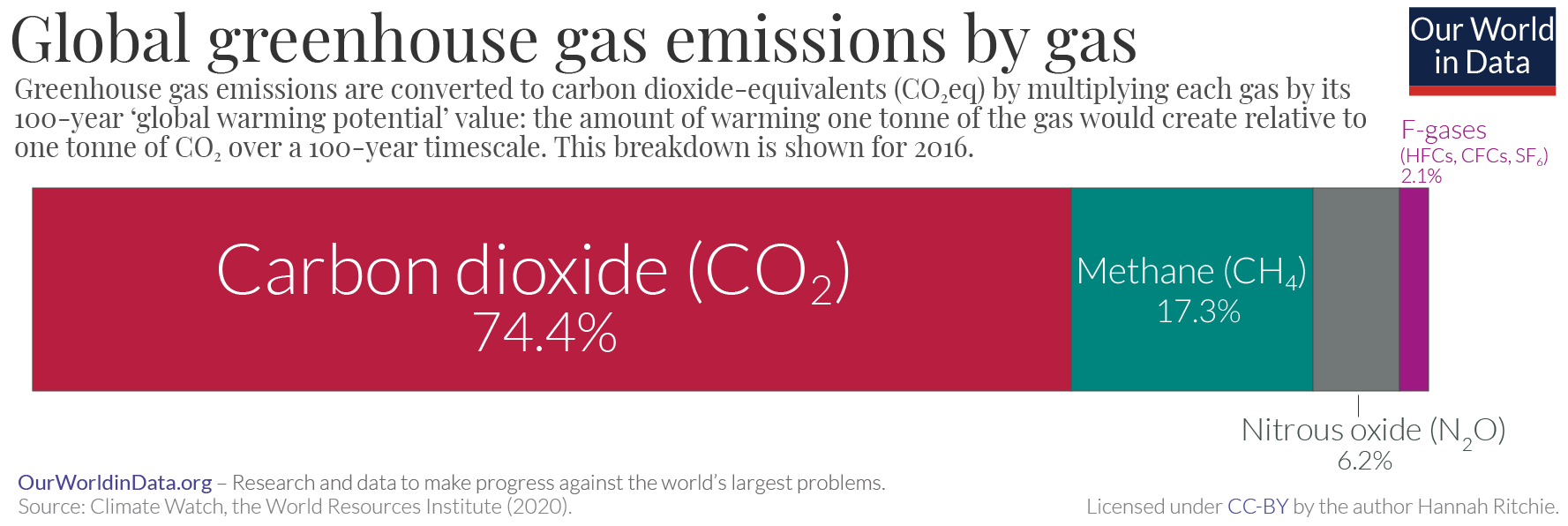|
Deep Fryer
A deep fryer (or deep fat fryer), sometimes referred to by the French name friteuse, is a kitchen appliance used to cook foods by full immersion in hot oil—deep frying. The cooking oil (or fats) are typically between temperatures of . Long common in commercial kitchens, household models now available have become increasingly prevalent. Deep frying has become well known in the United States, from frying sticks of butter to Twinkies, but the method can be traced back to Roman times. Features Deep fryers generally have a basket to lower the food into the oil tank and raise it when the food has finished cooking. Fryer baskets purchased separately are not standardized and when selected, need to fit into the deep fryer. There are timers and alarms, automatic devices to raise and lower the basket into and out of the oil, ventilation systems to exhaust frying odors from the kitchen, an oil filtration system or chemical treatment to improve the re-usability of the same amount of o ... [...More Info...] [...Related Items...] OR: [Wikipedia] [Google] [Baidu] |
Diatomaceous Earth
Diatomaceous earth ( ), also known as diatomite ( ), celite, or kieselguhr, is a naturally occurring, soft, siliceous rock, siliceous sedimentary rock that can be crumbled into a fine white to off-white powder. It has a particle size ranging from more than 3 millimeter, mm to less than 1 micrometre, μm, but typically 10 to 200 μm. Depending on the granularity, this powder can have an abrasive feel, similar to pumice powder, and has a low density as a result of its high porosity. The typical chemical composition of oven-dried diatomaceous earth is 80–90% silica, with 2–4% aluminum oxide, alumina (attributed mostly to clay minerals), and 0.5–2% iron oxide. Diatomaceous earth consists of the fossilized remains of diatoms, a type of hard-shelled microalgae, that have accumulated over millions of years. It is used as a filtration aid, mild abrasive in products including metal polishes and toothpaste, mechanical insecticide, absorption (chemistry), absorbent for ... [...More Info...] [...Related Items...] OR: [Wikipedia] [Google] [Baidu] |
Vacuum Fryer
A vacuum fryer is a deep-frying device housed inside a vacuum chamber. With vacuum frying it is easier to maintain natural colors and flavours of the finished product. Due to the lower temperatures applied (approximately ), the formation of suspected carcinogen acrylamide is significantly lower than in standard atmospheric fryers, where the frying temperature is approximately . The fat absorption of the products is also reported to be lower than in atmospheric fryers. In Southeast Asia (mainly the Philippines, Thailand, China and Indonesia) batch type vacuum fryers are mainly used for the production of fruit chips. However, these machines are only appropriate for relatively small production companies. Working principle Water boils at lower temperatures at lower pressure. As pressure decreases below that of the general atmosphere, the boiling point of water also drops below 100 °C (212 °F). Vacuum fryers allow food items to be fried at lower temperatures by lowering ... [...More Info...] [...Related Items...] OR: [Wikipedia] [Google] [Baidu] |
Sautéing
Sautéing or sauteing (, ; , , 'jumped', 'bounced', in reference to tossing while cooking) is a method of cooking that uses a relatively small amount of oil or fat in a shallow pan over relatively high heat. Various sauté methods exist. Description Ingredients for sautéing are usually cut into small pieces or thinly sliced to provide a large surface area, which facilitates fast cooking. The primary mode of heat transfer during sautéing is conduction between the pan and the food being cooked. Food that is sautéed is browned while preserving its texture, moisture, and flavor. If meat, chicken, or fish is sautéed, the sauté is often finished by deglazing the pan's residue to make a sauce. Sautéing may be compared with pan frying, in which larger pieces of food (for example, chops or steaks) are cooked quickly in oil or fat, and flipped onto both sides. Some cooks make a distinction between the two based on the depth of the oil used, while others use the terms interchange ... [...More Info...] [...Related Items...] OR: [Wikipedia] [Google] [Baidu] |
List Of Deep Fried Foods
This is a list of deep fried foods and dishes. Deep frying is a cooking method in which food is submerged in hot fat, such as cooking oil. This is normally performed with a deep fryer or chip pan, and industrially, a pressure fryer or vacuum fryer may be used. Deep frying is classified as a dry cooking method because no water is used. Due to the high temperature involved and the high heat conduction of oil, the food is then prepared quickly. Deep fried foods * * * * * * * * * * * * * * * * * * * * * * * ** * * * * * * ** Czech '' Smažený sýr'' ** Slovakian '' Vyprážaný syr'' * * * * * * * * * * * * ('' Coxinha'') * * * : * * * * * * * * * * * * * * * * * * * * * * * * * * * * * * * * * * * * * * * * * * * * * * * * * * * * * * * * – the Puerto Rican version * * * ** * * * * * * * * * * * * * * * * – some varieties are deep fried * * * * ... [...More Info...] [...Related Items...] OR: [Wikipedia] [Google] [Baidu] |
List Of Cooking Appliances
This is a list of cooking appliances that are used for cooking foods. Cooking appliances Boilers * Coffee percolator * Coffeemaker * Electric water boiler * Instant hot water dispenser * Kettle See also * Appliance recycling * Cooker * Food processing * Induction cooking * List of cooking techniques * List of food preparation utensils * List of home appliances * List of ovens This is a list of oven types. An oven is a thermally insulated chamber used for the heating, baking or drying of a substance, and most times used for cooking or for industrial processes (industrial oven). Kilns and Furnace (other)#Applia ... * List of stoves References {{DEFAULTSORT:Cooking appliances Cooking appliances Technology-related lists Food- and drink-related lists ... [...More Info...] [...Related Items...] OR: [Wikipedia] [Google] [Baidu] |
Chip Pan
A chip pan is a deep-sided cooking pan used for deep-frying. Chip pans are named for their traditional use in frying French fries, chips (called "French fries" in the United States). Today, they are made from either aluminium or stainless steel, although in the past were commonly made from cast iron. A basket is placed inside the pan, to lower the chips into the hot cooking oil, and to raise them once cooked. Chip pans are commonly used in the United Kingdom and Republic of Ireland, although are slowly being rendered obsolete by deep fryers. Manufacture Chip pans are commonly manufactured through a spinning process, as the metal used is malleable. The lid is typically stamped out by a die in a heavy press. Safety and health Repeated heating of oil is believed to greatly increase the free radicals in the oil, leading to a higher risk of heart disease. Injuries, particularly to children, caused by the hot oil from a chip pan falling on them are a common cause of hospital ... [...More Info...] [...Related Items...] OR: [Wikipedia] [Google] [Baidu] |
Flash Point
The flash point of a material is the "lowest liquid temperature at which, under certain standardized conditions, a liquid gives off vapours in a quantity such as to be capable of forming an ignitable vapour/air mixture". The flash point is sometimes confused with the autoignition temperature, the temperature that causes spontaneous ignition. The fire point is the lowest temperature at which the vapors keep burning after the ignition source is removed. It is higher than the flash point, because at the flash point vapor may not be produced fast enough to sustain combustion. Neither flash point nor fire point depends directly on the ignition source temperature, but ignition source temperature is far higher than either the flash or fire point, and can increase the temperature of fuel above the usual ambient temperature to facilitate ignition. Fuels The flash point is a descriptive characteristic that is used to distinguish between flammable fuels, such as petrol (also known as g ... [...More Info...] [...Related Items...] OR: [Wikipedia] [Google] [Baidu] |
Greenhouse Gas Emissions
Greenhouse gas (GHG) emissions from human activities intensify the greenhouse effect. This contributes to climate change. Carbon dioxide (), from burning fossil fuels such as coal, petroleum, oil, and natural gas, is the main cause of climate change. The top contributors to greenhouse gas emissions, largest annual emissions are from China followed by the United States. The United States has List of countries by greenhouse gas emissions per capita, higher emissions per capita. The main producers fueling the emissions globally are Big Oil, large oil and gas companies. Emissions from human activities have increased Carbon dioxide in Earth's atmosphere, atmospheric carbon dioxide by about 50% over pre-industrial levels. The growing levels of emissions have varied, but have been consistent among all greenhouse gases. Emissions in the 2010s averaged 56 billion tons a year, higher than any decade before. Total cumulative emissions from 1870 to 2022 were 703 (2575 ), of which 484±20 (177 ... [...More Info...] [...Related Items...] OR: [Wikipedia] [Google] [Baidu] |
Biodiesel
Biodiesel is a renewable biofuel, a form of diesel fuel, derived from biological sources like vegetable oils, animal fats, or recycled greases, and consisting of long-chain fatty acid esters. It is typically made from fats. The roots of biodiesel as a fuel source can be traced back to when J. Patrick and E. Duffy first conducted transesterification of vegetable oil in 1853, predating Rudolf Diesel's development of the diesel engine. Diesel's engine, initially designed for mineral oil, successfully ran on peanut oil at the 1900 Paris Exposition. This landmark event highlighted the potential of vegetable oils as an alternative fuel source. The interest in using vegetable oils as fuels resurfaced periodically, particularly during resource-constrained periods such as World War II. However, challenges such as high viscosity and resultant engine deposits were significant hurdles. The modern form of biodiesel emerged in the 1930s, when a method was found for transforming vegetable ... [...More Info...] [...Related Items...] OR: [Wikipedia] [Google] [Baidu] |
Recycle
ReCycle is a music loop editor designed and developed by Sweden, Swedish software developers Propellerhead Software. It runs on Microsoft Windows and Apple Macintosh based Personal Computer, PCs. The software debuted in 1994. The principal idea of ReCycle is to alter the tempo of a music loop without changing its Pitch (music), pitch or otherwise altering its sound. ReCycle does this by "slicing" loops into a series of separate "beats" or "hits" and altering their timing (or even quantizing them) without altering the length of the individual slices, thus allowing the loop to play at a different speed whilst using the unmodified sounds for each individual slice/drum hit, a process which fully preserves the original pitch of the loop while allowing a great variety of speed/timing tweaks. ReCycle can also assign each successive slice to a respective MIDI note on a scale. ReCycle was the first program to popularize the idea of loop slicing. Propellerhead developed their own file for ... [...More Info...] [...Related Items...] OR: [Wikipedia] [Google] [Baidu] |
Synthetic Magnesium Silicate
Synthetic magnesium silicates are white, odorless, finely divided powders formed by the precipitation reaction of water-soluble sodium silicate (water glass) and a water-soluble magnesium salt such as magnesium chloride, magnesium nitrate or magnesium sulfate. The composition of the precipitate depends on the ratio of the components in the reaction medium, the addition of the correcting substances, and the way in which they are precipitated.Ralph K. Iler, The Chemistry of Silica: Solubility, Polymerization, Colloid, and Surface Properties, and Biochemistry, John Wiley and Sons (1979)Krysztafkiewics, A., Lipska, L.K., Ciesielczyk, F., and Jesionowski, T. Amorphous magnesium silicate – synthesis, physicochemical properties and surface morphology. Advanced Powder Technol, 15, 549, 2004.Ciesielczyk, F., Krysztafkiewics, A., Jesionowski, T. Physicochemical studies on precipitated magnesium silicates. J Mater Sci. 42, 3831, 2007. The molecular formula is typically written as MgO:XSiO2, ... [...More Info...] [...Related Items...] OR: [Wikipedia] [Google] [Baidu] |






